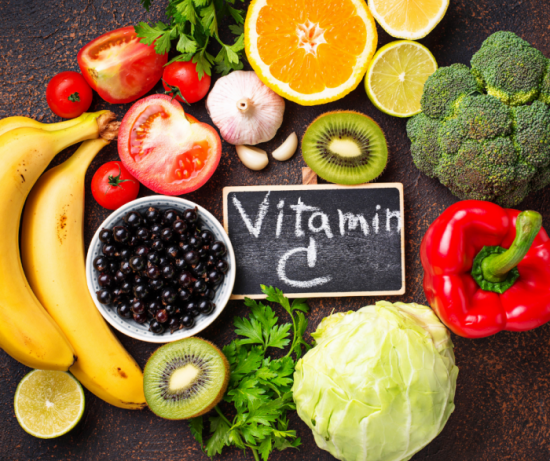Overview
Vitamin C is an essential compound that cannot be synthesized inside the body.
Consequently, the unique source to get vitamin C is through the dietary intake (e.g., fruits, vegetables). Sadly, the vast majority of the general population does not get sufficient amounts of this vital compound through their diet.
In this article, we will discuss the positive effects of this compound on the body, as well as vitamin C foods and fruits.
Vitamin C benefits
Risk reduction of several ailments
Oxidative stress describes a cellular state where there is an imbalance between the number of reactive oxygen species (ROS) and antioxidants.
When the number of ROS exceeds that of antioxidants, the risk of cellular damage and DNA mutations is substantially higher.
For years, scientists tried to find a connection between oxidative stress and different disease processes; they found that a significant number of chronic illnesses result from the direct or indirect effects of oxidative stress. Some of these ailments include coronary artery disease (CAD), type 2 diabetes, and chronic blood hypertension.
The good news is that vitamin C is an excellent antioxidant that possesses potent neutralizing properties against free radicals, making it the perfect compound to prevent degenerative pathologies.
In a 2015 study, scientists concluded that the regular intake of vitamin C could reduce oxidative stress by a whopping 30%.
Decreases risk of cardiovascular disease
Coronary artery disease is the leading cause of death around the globe. The pathophysiology of this ailment involves the irreversible occlusion of the blood vessels responsible for supplying the heart muscle.
Consequently, myocytes (heart cells) start to die, which eventually leads to fatal arrhythmias and death. Despite the advances made in the management of CAD, the optimal approach is still prevention.
One meta-analysis found that taking 700 mg of vitamin C daily reduces the risk of CAD by up to 25% relative to the control group.
Experts attribute these results to the potent antioxidative properties of vitamin C.
Helps with iron deficiency
Iron deficiency anaemia is the most common type of anaemia in the world. The key disruption that causes this disease is the low amounts of iron in the blood, which is a crucial element to the synthesis of red blood cells.
Here are some of the common causes of iron deficiency anaemia:
- Excessive bleeding
- Malabsorption (e.g., celiac disease, Crohn’s disease)
- Malnutrition
- Genetic disorders
What most people don’t know is that vitamin C is essential for the proper absorption of iron, and a deficiency in the former can lead to iron deficiency anaemia.
Reversely, taking vitamin C can reduce the symptoms of iron deficiency anaemia, even without iron supplementation.
Boosts the immune system
Most people believe that vitamin C treats the common cold and flu symptoms during the winter season.
Despite the lack of any evidence to support vitamin C’s ability to treat and/or prevent the common cold, there are some findings that back up this compound’s ability to promote white blood cell production.
Despite the inconclusiveness of these findings, people still swear by vitamin C as a treatment option for upper respiratory infections.
Good sources of vitamin C

Here is a list of vitamin C foods and fruits:
- Guava
- Aamla
- Citrus fruits (e.g., Lemon, orange, grapefruit)
- Kiwi fruit
- Raspberries
- Blueberries
- Strawberries
- Mango
- Papaya
- Pineapple
- Watermelon
How much vitamin C should I take?
Perhaps the most common question asked by people interested in taking vitamin C supplementation is the appropriate dosage.
Unfortunately, the answer to this question varies, depending on your gender and age.
Here are some relative numbers:
- Children (1–3 years) 15 mg
- Kids (4–8 years) 25 mg
- Adolescents (9–13 years) 45 mg
- Adolescents (14–18 years) 65–75 mg
- Adult women (+19 years) 75 mg
- Adult men (+19 years) 90 mg
- Pregnant women 85 mg
- Breastfeeding women 120 mg
Note that the dosages above are quoted from the Recommended Dietary Allowance (RDA) guidelines.
Vitamin C toxicity
Since the upper limit of vitamin C intake is relatively high, it is unlikely to experience any side effects from regular use.
With that said, you can expect the following signs and symptoms if you consume a large amount of vitamin C in a short period:
- Digestive symptoms (e.g., diarrhoea, cramping, abdominal pain)
- Nausea and vomiting
- Headaches
- Sleeping problems
Takeaway message
Vitamin C is an essential compound that offers the body several health benefits, affecting the vast majority of organ systems.
Hopefully, this article managed to shed some light on the richest vitamin c foods and fruits, as well as its potential health benefits.










